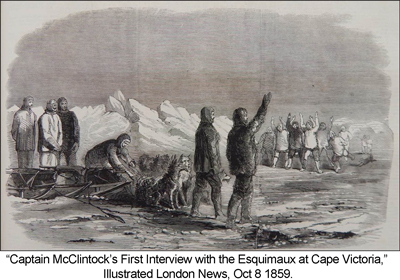The Franklin Mystery: Life and Death in the Arctic (Lyle Dick)

Few mysteries in Canadian history have so captivated scholars and the general public alike as the mystery of what really happened to the 128 members of the missing last expedition of Sir John Franklin who sailed into the Canadian Arctic in 1845 and were never heard from again. Innumerable debates have since taken place regarding the ill-fated expedition, represented in a proliferation of books, articles, and other commentaries offering further evidence and interpretations, but many questions remain regarding what actually happened to Franklin and his compatriots.
The Franklin Mystery: Life and Death in the Arctic is the latest installment in the highly successful Great Unsolved Mysteries in Canadian History (GUMICH) project, the remarkably successful web based series devoted to posing historical mysteries and providing primary documents, curriculum, and other materials to students and teachers concerning major events in Canadian history. It presents a rare opportunity to examine and re-evaluate the diverse strains of Franklin historiography. Of particular interest are two very distinctive approaches bearing upon the principal and secondary questions arising from the Franklin story, including the contrasting roles of participants and witnesses of two very different cultures and knowledge systems – Inuit and European. Through the assemblage of extensive evidence generated by numerous Inuit and European witnesses, students will be challenged not only to try to solve the mystery of Franklin’s fate but also to evaluate our notions of historiographical methods, authority, and truth. The Franklin Mystery website will be formally launched in Ottawa in June 2015 following its complete translation into both official languages. The site will be subsequently available in Inuktitut.
The Franklin Mystery meets the Mystery Projects’ three main criteria for a great history education website. First, the original story of the Franklin expedition to the Canadian Arctic is filled with the kind of adventure and danger that is intrinsically and immediately interesting to young people – the first criterion in selecting each of the mysteries on the website. While the original mystery is intriguing, more recent attempts to find out “what really happened” – and particularly Parks Canada’s search for the lost ships – add another layer of immediate interest by providing intriguing details on the work of historical detectives. We are adding the voices and the experiences of Arctic historians and some of the scientists working on the Parks Canada project as part of the website.
 Second, the Franklin Expedition is an episode of considerable significance in Canadian history. It embodies two major, intersecting stories – the European search for the Northwest Passage, primarily post-1818, and Inuit life and adaptation in the Arctic over many hundreds of years. Further, extensive British exploration during the search confirmed the United Kingdom’s claim to sovereignty over most of the Arctic Islands and the search set the stage for the subsequent transfer of title of the Arctic archipelago to Canada in 1880, thereby enabling its incorporation as one of this country’s major regions. Of considerable significance in itself, the Franklin Mystery provides insight into several themes of critical importance to the history of Canada as a whole, including:
Second, the Franklin Expedition is an episode of considerable significance in Canadian history. It embodies two major, intersecting stories – the European search for the Northwest Passage, primarily post-1818, and Inuit life and adaptation in the Arctic over many hundreds of years. Further, extensive British exploration during the search confirmed the United Kingdom’s claim to sovereignty over most of the Arctic Islands and the search set the stage for the subsequent transfer of title of the Arctic archipelago to Canada in 1880, thereby enabling its incorporation as one of this country’s major regions. Of considerable significance in itself, the Franklin Mystery provides insight into several themes of critical importance to the history of Canada as a whole, including:
- History of First Peoples in the Canadian North
- History of first contact between Aboriginal and non-Aboriginal peoples
- Environmental History, by illuminating the importance of climate and geography
- History of Arctic and northern exploration
- British colonial attitudes toward the North
- Arctic exploration and scientific investigation
- The place of the North in Canadian history
Third, there is a rich evidential base relating to the mystery of the Franklin Expedition. Research in repositories in the United Kingdom, Canada, and the United States has resulted in the collection of a wide array of archival documents relating to Franklin’s expedition and those who later set out to find it. The primary resources include correspondence between Sir John and Lady Franklin and senior members of the British Admiralty, ships’ log books, and expedition records; oral histories of Inuit interviewed in the nineteenth, twentieth, and twenty-first centuries; and accounts of material evidence, autopsies, period newspapers, and many other textual sources. Visual evidence includes European and Inuit maps, historical photographs, drawings, and paintings. The research materials also comprise numerous secondary sources, including books, articles, a variety of scientific reports, and aerial and other modern-day photographs. The Mystery also incorporates a wealth of materials relating to Parks Canada’s current search for the missing ships M.S. Erebus and Terror. By providing a rich assemblage of research materials, and contextualizing them, the Franklin Mystery will make this enduring historical mystery accessible to students and the public alike while fostering the serious study of Canadian history through direct encounters with the tangible evidence of our past.

